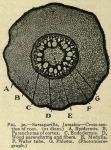 The dried root of Smi'lax officinalis Kunth, Smi'lax med'ica Chamisso et Schlechtendal, Smilax papyra'cea Duhamel, Smilax ornata Hooker, and of other undetermined species of Smilax.
The dried root of Smi'lax officinalis Kunth, Smi'lax med'ica Chamisso et Schlechtendal, Smilax papyra'cea Duhamel, Smilax ornata Hooker, and of other undetermined species of Smilax.
BOTANICAL CHARACTERISTICS.—Evergreen, climbing, shrubby plants. Stem prickly. Leaves alternate, netted-veined, coriaceous, ovate-oblong, with a cordate base, 1 foot long and 4 to 5 inches broad. Flowers in axillary clusters, dioecious; stigmas 3, sessile. Fruit a globular, 1- to 3-seeded berry.
HABITAT.—Tropical America, in swampy forests.
DESCRIPTION OF DRUG.—The varieties used in medicine have a thick, knotty rhizome (which, if present, should be removed) from which grow in a horizontal direction the fleshy roots. These appear in the market several feet in length, cylindrical, about the thickness of a quill, very flexible; externally longitudinally wrinkled, of various colors, depending upon the variety, generally ash-colored, grayish-brown, or reddish-brown; internally whitish, horny, or occasionally mealy; nearly inodorous; taste mucilaginous, bitter, and acrid.
STRUCTURE.—A transverse section shows a thin, easily removed epidermis overlaying a thick cortical layer; this inner bark consists of loose parenchyma, the cells of which, when not devoid of solid contents, are filled with starch-granules or paste, and occasionally calcium oxalate raphides; a brownish ring (nucleus sheath) separates it from the woody center, which is made up of elongated woody cells. A small pith runs through the center of this woody zone.
VARIETIES.—There are four principal varieties of sarsaparilla, differing somewhat in appearance, and especially in the condition of the starch.
(a) Mealy-starch in granules (see Part iv).
The Honduras sarsaparilla is the kind most generally used in this country. It is grayish or grayish-brown from adhering dirt, beset with a few fibers, and comes in compact cylindrical bundles 2 or 3 feet long.
Brazilian sarsaparilla (Rio Negro, Para, or Lisbon sarsaparilla). Considered to be the finest variety. Dark brown or blackish-brown, with a thick cortical layer and pith, and a narrow, woody zone.
(b) Pasty-starch in a paste.
Jamaica or red sarsaparilla is of a reddish color externally; it is said to be the richest in extractive and to contain the best quality of starch. The name bearded sarsaparilla has been applied to it, from the numerous fibers attached.
Mexican sarsaparilla is deeply wrinkled, and brownish-gray from adhering earth. The woody zone and pith are about equal in thickness, each being about half as broad as the cortical layer.
Powder.—Characteristic elements: See Part iv, Chap. I, B.
CONSTITUENTS.—The activity of sarsaparilla depends upon an acrid glucoside, parillin, C26H44O10 + 2 ½ H2O (variously termed smilacin, parillinic acid, pariglin, etc.), frothing with water and otherwise closely resembling saponin in action. Kobert states that two other glucosides are present, saponin (sarsaparilla saponin), 5(C20H32O10) - 2 ½ H2O, and sarsa-saponin, 12(C2235H36O10) + H2O. These two latter differ from parillin in their being soluble, while parillin is insoluble. The latter constituent is the most poisonous. Ash, not exceeding 10 per cent.
Preparation of Parillin—Exhaust with warm alcohol and concentrate the liquid to a syrup; add 1 ½ times its weight of water; macerate for several days, when a yellow precipitate will form; decant and mix with alcohol, and wash on a filter with 20 per cent. alcohol.
ACTION AND USES.—The efficiency of sarsaparilla as a remedial agent has been and is still much questioned, some declaring it almost inert, others ascribing to it valuable alterative and antisyphilitic properties. Preparations from good, well-preserved specimens are perhaps beneficial remedies in scrofulous affections, and as general bloodpurifiers. Dose: 30 to 60 gr. (2 to 4 Gm.).
- OFFICIAL PREPARATIONS.
- Fluidextractum Sarsaparillae, Dose: 30 to 60 (minim?) (2 to 4 mils).
- Syrupus Sarsaparillae Compositus (fl'ext. 20 per cent., with the fluidextracts of glycyrrhiza and senna, and the oils of sassafras, anise, and gaultheria), 2 to 3 fl. dr. (8 to 15 mils).
- Fluidextractum Sarsaparillae Compositum (75 per cent., with glycyrrhiza, sassafras, and mezereum), ½ to 1 ½ fl. dr. (2 to 6 mils)




